37 F. average high on March 8.
39 F. high on March 8, 2013.
16" snow on the ground.
40s likely today and Monday, again later this week.
50+ by Tuesday of next week?
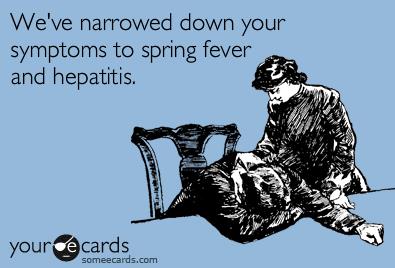
Springing Forward
I set my clock ahead one hour last night. Now I'd like to set my calendar ahead one month. Mid April. Yes, frantic calls with my tax accountant, maybe a stray flood warning or premature mosquito to swat?
I can't promise spring fever, but for the first time in nearly 4 months you'll be able to exhale as highs SOAR into the 40s. Birds may chirp hopefully, neighbors emerging from deep hibernation, rubbing their eyes nervously, peeling off a few extra layers of clothing.
Last year it snowed in May; this winter was far colder, turning highways into ice-encrusted ruts of torment. A brewing El Nino (52 percent risk) may tilt the odds slightly in favor of warmer weather later in 2014 and possibly ease the drought for California. Expect more volatility.
But today a sun-kissed airmass direct from Seattle lures the mercury above 40F; mid 40s and an unusual number of smiles for a Monday - give way to cooler weather by midweek. A Tuesday storm may brush southern Minnesota with wet snow; it doesn't look like a big deal right now.
Look at the bright side: no subzero lows in sight, and NOAA predicts an end to our moderate drought. I just want the glacier in my yard to melt.
Any day now.
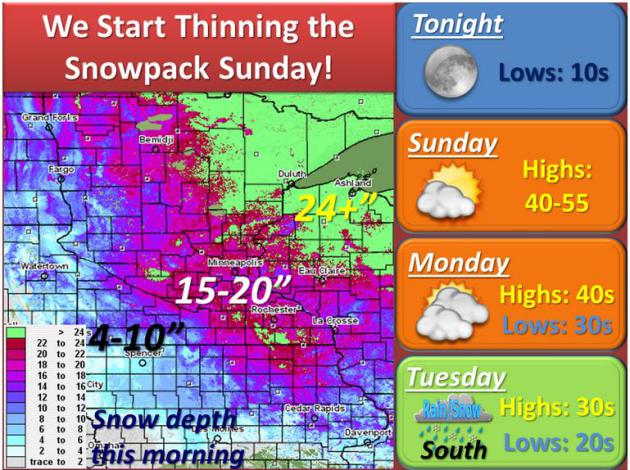

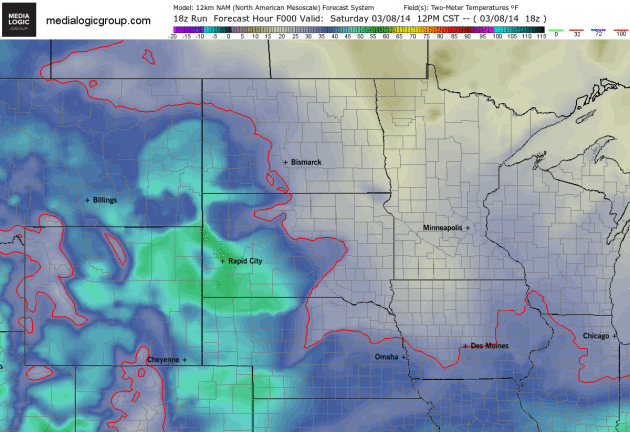


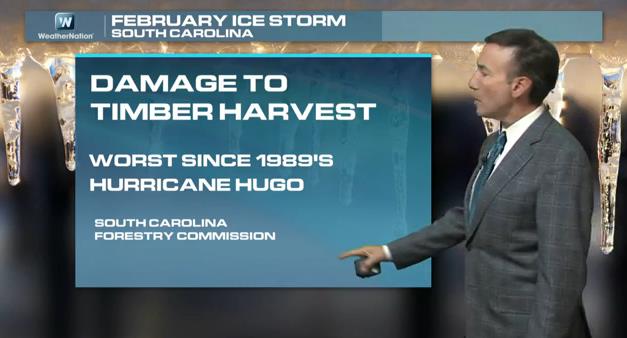
Super-Sized Winter of 2014: Ice More Damaging Than Snow.
Snow gets much of the national media attention, but ice is far more
dangerous and damaging, sparking more accidents, roof collapses and
downed tree limbs and power lines. That's the subject of today's edition
of Climate Matters: "Yes,
this has been a jaw-dropping, super-sized, winter on steroids winter
east of the Rockies." -- Meteorologist Paul Douglas said. A crazy winter
it has been for much of the U.S. as snow, ice and freezing rain
continues into March. The Great Lakes are breaking ice-cover records and
snow covered 54% of the U.S. as of Tuesday, the most since 1978. It has
been a wild one."
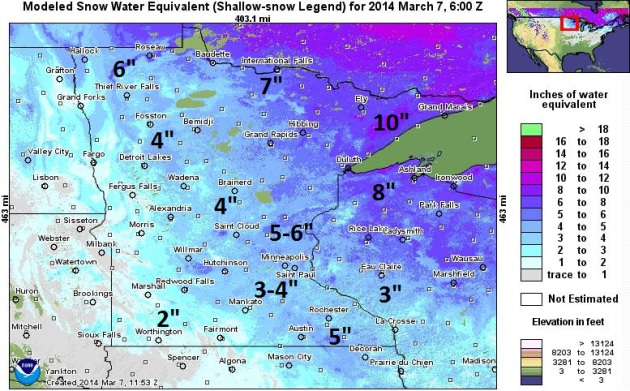
Snow Water Equivalent.
The latest numbers from NOAA estimate 3-4" of liquid water trapped in
the snow pack over the south metro, but closer to 5-6" from Isanti and
Cambridge to Taylors Falls, as much as 10" along Lake Superior's North
Shore. Pray for a gradual thaw (with no heavy rain).
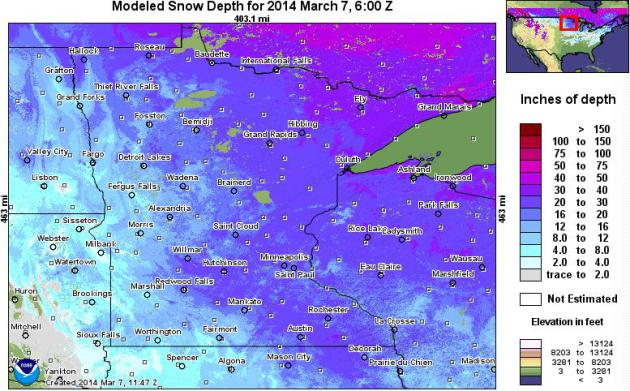
Unusually Deep Snow Over Northeastern Minnesota.
In his most recent post, Dr. Mark Seeley answers a listener question
about the deep snow pack along the North Shore and over the Minnesota
Arrowhead. Here's an excerpt of his response at Minnesota WeatherTalk: "...Though
not record-setting it is rare to have snow depths over 40 inches, yet
several observers have reported these amounts for this winter including
47 inches near Two Harbors, 43 inches at Isabella, 42 inches at Wolf
Ridge and Babbitt, 41 inches at Cook, and 40 inches at Cloquet and Grand
Marais. The measurement of 47 inches neat Two Harbors is the deepest
snow there since they measured 51 inches in March of 1965. Similarly at
Babbitt the reading of 42 inches is the most there since a snow depth of
52 inches in February of 1969. The state record by the way is a snow
depth of 75 inches at Pigeon River Bridge in March of 1950..."
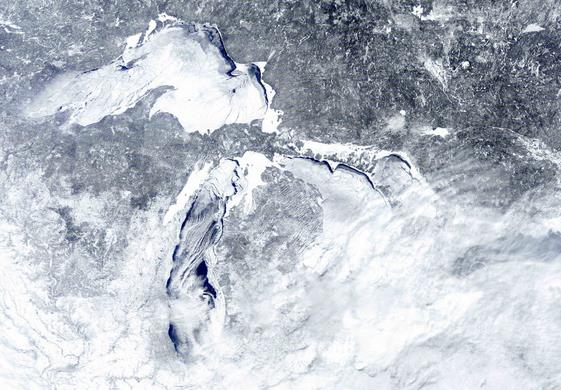
Snow, Ice Cover Will Boost Great Lakes Ice Levels. AP has the article - here's a link and excerpt: "Water
levels in the Great Lakes are expected to continue a steady recovery
this year, courtesy of widespread ice cover that is slowing evaporation
and snowfall that has approached record amounts in some cities, federal
experts said Wednesday. The siege of polar air that has gripped the
region this winter has caused the most extensive freeze-over of the
lakes since the record-setting year of 1979, when nearly 95 percent of
their surface area solidified. On Tuesday, the ice cover reached its
highest point since then - 91 percent, said George Leshkevich, a
physical scientist with the federal Great Lakes Environmental Research
Laboratory in Ann Arbor..."
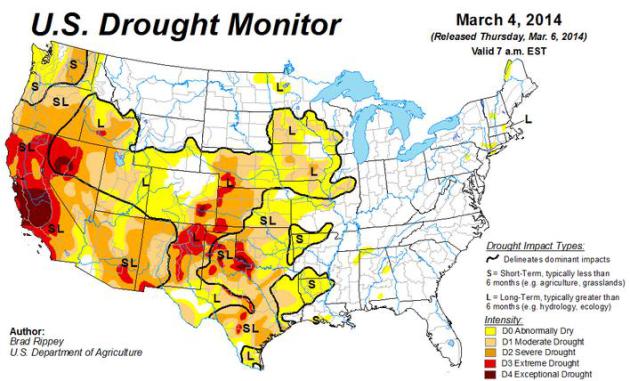
Trapped In A Devastating Drought, California Needs To Take On Some Surprising Sacred Cows. Here's a clip from a story at New Republic which puts the the drought into stark perspective: "...Today
in California, a different kind of resource shock is unfolding, and it
too may end up, a generation hence, defining an era. This time the
resource is water, not oil. Today’s California drought is starting to
force similarly life-changing choices, this time in the nation’s most
populous state, long a bellwether and, according to some counts,
the world’s eighth largest economy. The land of milk and honey has
begun in recent weeks to get serious about its water crisis: Farmers are
ripping out crops, religious believers are praying for rain, and local
governments are ordering restaurants to stop serving glasses of water
except to diners who specifically request them. This comes at a time
when America’s domestic supply of the natural resource it has cared most
about—fossil fuel—is more plentiful than ever..."

- In a warming world, a larger fraction of total precipitation falls in downpours, which means a larger fraction is lost to storm runoff (as opposed to being absorbed in soil).
- In mountain regions that are warming, as most are, a larger fraction of precipitation falls as rain rather than as snow, which means lower stream flows in spring and summer.
- What snowpack there is melts earlier in a warming world, further reducing flows later in the year.
- Where temperatures are higher, losses of water from soil and reservoirs due to evaporation are likewise higher than they would otherwise be..."
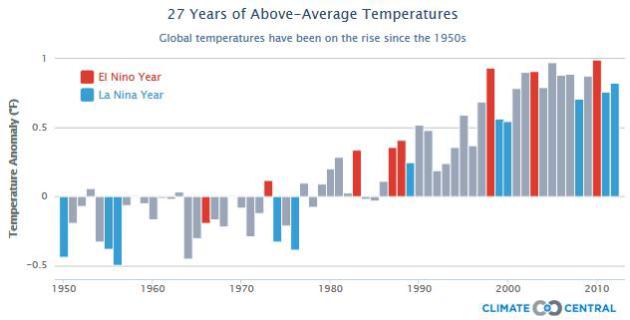
Get Ready For The Next Climate Phenomenon: El Nino.
As we told you yesterday the probabilities of lurching into an El Nino
warming phase of the Pacific are increasing for later in 2014. The
implications for Minnesota and the rest of the nation? Here's an excerpt
from Climate Central: "...An
El Niño increases the likelihood of wet conditions in California and
the Southwest, which could provide relief to areas suffering through severe drought. Warm conditions are also more likely in the Northeast. That’s welcome news for a region where teeth have been chattering
all winter. The Eastern Seaboard could also see the major hurricane
drought stretch for another year as El Niño tends to inhibit the
formation of Atlantic Hurricanes. The last official major hurricane to
make landfall in the U.S. was Hurricane Wilma in 2005..."
Image credit above: "Global average surface temperatures, showing El Niño years in red." Credit: Climate Central using WMO data.

Photo credit: "Vehicles clog a highway during a hazy day in Beijing at the end of February." Photograph: Ng Han Guan/AP

Facebook Looks To Buy Solar-Powered Drone Company To Deliver Worldwide Internet.
Because I can't get FB in nearly enough places. I want to be able to
update my profile while steaming off the coast of Nigeria. Gizmag has the story; here's the intro: "Titan Aerospace's Solara,
a solar-powered unmanned aerial vehicle designed to cruise at an
altitude of 20 km (12.42 miles) for five years at a time, certainly got
our attention back in August, and it appears to have not gone unnoticed
by some of tech's bigger players either. Facebook is reportedly in talks
to acquire the company with a view to using the drones as a means of
providing internet access to the world's under-served regions..."

SAT Scores Of The Rich And Famous. I'm not surprised about Bill Gates, but Ke$ha scoring a 1500? Impressive. The New York Times has the blurb - here's an excerpt: "...The
cover story of this weekend’s magazine has the background of the SAT
overhaul. You can get an early look at it online Thursday morning. Until
then, here are the SAT scores that go with some boldfaced names, as
reported in places other than Twitter.
1. Ben Affleck: “Ben had almost perfect SAT scores in high school.”
2. Ke$ha: 1,500
3. Bill Gates: 1,590
4. George W. Bush: 1,206
5. Al Gore: 1,355
6. Scarlett Johansson: 1,080
2. Ke$ha: 1,500
3. Bill Gates: 1,590
4. George W. Bush: 1,206
5. Al Gore: 1,355
6. Scarlett Johansson: 1,080

The Future Of TV Is Coming Into Focus, And Looks Pretty Great.
Will every show you care about eventually be delivered online, and
on-demand? What will this do to traditional network TV schedules? Are we
heading to more of a Netflix model for most of our entertainment? Quartz has a thought-provoking article; here's the introduction: "The future of TV is here. It’s just not evenly distributed. If
it doesn’t seem like the American television industry is in the middle
of a dramatic transformation, that’s simply because the pieces are
scattered all over the place. But they are starting to come together. One transformative piece arrived earlier this week, when Dish Network secured the rights to
include ABC, ESPN, and other popular channels owned by Disney in a TV
service delivered entirely over the internet. Negotiating deals like
that one has generally been the biggest impediment to internet TV in the
United States..."

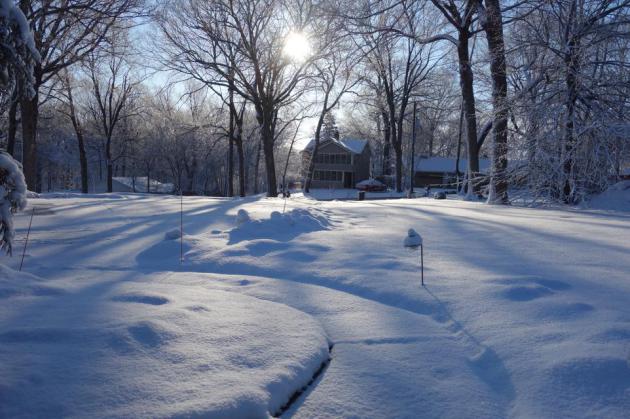
TODAY: Partly sunny, breezy, much nicer. Winds: SW 15. High: 43
SUNDAY NIGHT: Partly cloudy, patchy fog. Low: 36
MONDAY: Hints of early April. Patchy clouds & fog. High: 46
TUESDAY: Chance of snow southern Minnesota. Wake-up: 32. High: 36
WEDNESDAY: Sun returns, light winds. Wake-up: 24. High: 34
THURSDAY: Intervals of sun, quite pleasant. Wake-up: 28. High: 43
FRIDAY: Some sun, a bit cooler. Wake-up: 30. High: 41
SATURDAY: Mix of clouds and sun, still quiet. Wake-up: 26. High: 38
Climate Stories....

Amen.


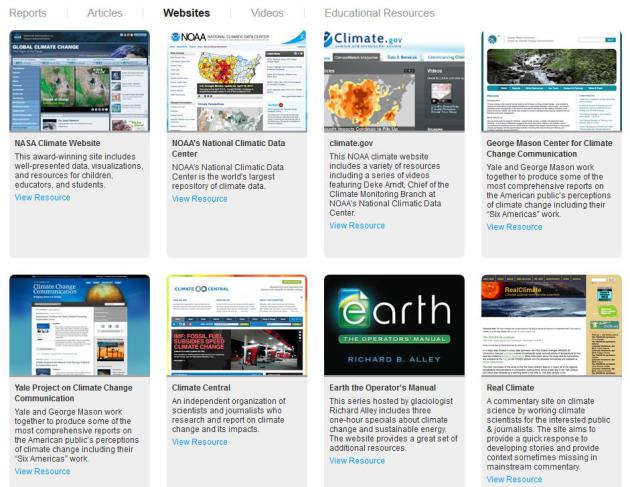


No comments:
Post a Comment